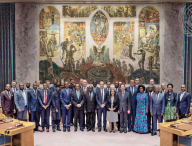Events surrounding the COVID-19 crisis have brought into focus the extent to which multilateralism generally, and the United Nations specifically, will be a central theatre for engagement between the United States and China in the years ahead. The role and powers of the World Health Organization (WHO), for example, have emerged as a canvas onto which a variety of actors have projected their visions of the future of multilateralism. However, to see how these engagements will play out, it is important to first have an understanding of the deeper, longer-term trendlines regarding US-China engagement at the UN before COVID-19 hit. This study aims to assist in providing that context.
The US and China are the world’s two biggest economies and geopolitical powers. The US has the world’s largest military budget. By personnel, China has the world’s largest military. Washington and Beijing are also two of the UN’s most important stakeholders. The UN was created at the initiative of the US after World War II. The UN Security Council sits at the apex of a 75-year old Rules-Based International Order heavily devised and underwritten by Washington. The US and China are the two largest financial contributors to both the UN general budget and the UN peacekeeping budget. China provides more troops to UN peacekeeping operations than any other P5 country. Chinese nationals head more UN specialist agencies than nationals of any other UN Member State.
Even before the advent of COVID-19, the traditional foreign policies of both the US and China had been evolving over recent years. Under the Trump Administration, the US’ global outlook has become more transactional, mercantile, nationalist and unpredictable – with a greater emphasis on sovereignty and a reduced focus on alliances. Under President Xi, China’s foreign policy has similarly become more assertive and nationalist, with Deng Xioapoing’s dictum that the country’s strength should be hidden and time bided, no longer always followed. Beijing’s growing influence has been most evident in Asia – for example in the South China Sea and through the Belt and Road Initiative (BRI). However, China’s global footprint has been expanding too – for example, with the recent deployment of the Chinese navy in European waters and the reach of the BRI into European Union Member States.
US policy towards China has also shifted over the last few years. The Obama Administration’s approach of seeking to manage and guide China’s rise within the Rules-Based International Order as a responsible stakeholder has been replaced – partly as a product of Republican ideology and partly in response to growing Chinese assertiveness towards the US – by a more confrontational approach under the Trump Administration aimed at constraint and decoupling. This shift has been echoed by Democrats. Even before the advent of the COVID-19, geopolitical and economic tensions between Washington and Beijing were rising, including over trade, technology, currency valuation and human rights (particularly the treatment of Uyghur and other Muslim minorities in China’s Xinjang region). Some, such has Professor Niall Ferguson, now talk openly of a new, second Cold War.
Against this backdrop, this paper looks at US and Chinese policy and diplomacy towards the UN – and each other – in New York. It addresses four issues. First, US policy and diplomacy at the UN during the Trump Administration – and how this differs from previous administrations, in particular the Obama Administration. Second, Chinese policy and diplomacy at the UN, including how this has evolved over the past ten years since 2010. Third, how the US and China are engaging with each other at the UN, and how other UN Member States privately view this ‘G2’ dynamic. Fourth, how US-China relations in New York could develop over the next five years to 2025.
Download the report here.


